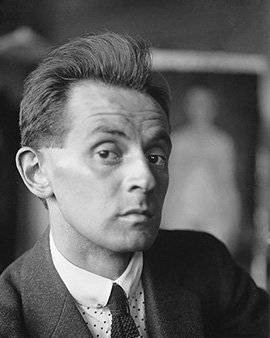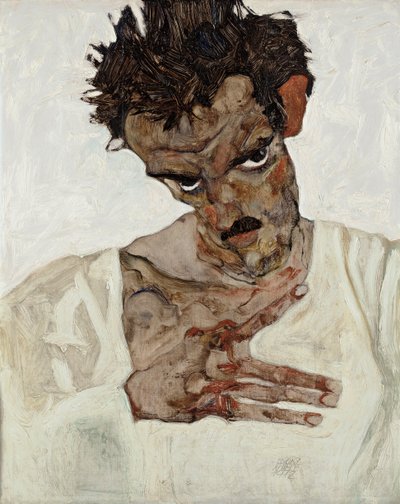Egon Schiele already stood out as a child with his extraordinary talent for drawing, the school achievements were not important to him. He absolutely wanted to paint and filled the sketchbooks with the impressions of his immediate surroundings. As the son of a stationmaster, he was initially occupied with motifs of railways and locomotives. Eventually, as a young artist, he ventured confidently into the Austrian art scene.
Full of optimism and encouraged by his art teacher Ludwig Karl Strauch, Egon Schiele began studying at the Academy of Fine Arts in Vienna in the winter semester of 1906/07. He applied in vain with his first works for participation in the spring exhibition of the Munich Secession in 1908. Fortunately, with the active support of well-known painters, the opportunity arose for Egon Schiele to exhibit as a young artist in the Augustinian Canon Monastery in Klosterneuburg.
At the Vienna Academy of Fine Arts, Egon Schiele founded a "new art group" with fellow students who were friends. He was tired of being trained only according to completely outdated methods. Egon Schiele felt deep inside himself the urge that an artist should break new ground and try out completely unexpected things with the means of painting. Important to him and the members of the group was the active participation in international exhibitions. Their works should not gather dust in the studio, but should be shown publicly.
Egon Schiele's nude paintings initially aroused indignation and rejection. How could a painter dare to show such almost pornographic depictions of naked bodies in public! But he was always interested in realistic art. Like the other representatives of Expressionism, he rejected the faithful reproduction of reality. Egon Schiele, as an artist, pushed for an abstract interpretation of reality; he wanted to show authentic feelings of women, men, children and couples. In addition to watercolours, ink and oil paints, he also used pencils for his erotic and at the same time delicately sketched nudes. He often used very strong, bright shades of colour.
The Austrian painter Gustav Klimt, also an opponent of official academicism at the art schools of the time, had long since become aware of Egon Schiele. The two artists were united by a close artistic friendship and at the same time benefited from each other in their work.
Schiele's self-portraits bear witness to the irrepressible creative enthusiasm of the painter and graphic artist. It is astonishing how many works he created in just a few years. As an outstanding representative of Expressionism, Egon Schiele unfortunately only had a short creative and life time, which he used intensively.
×





.jpg)
.jpg)
.jpg)
.jpg)
.jpg)
.jpg)
.jpg)
.jpg)
.jpg)
.jpg)
.jpg)
.jpg)
.jpg)
.jpg)
_-_(MeisterDrucke-636266).jpg)
_-_(MeisterDrucke-636266).jpg)
.jpg)
.jpg)
.jpg)
.jpg)
.jpg)
.jpg)
.jpg)
.jpg)
.jpg)
.jpg)
.jpg)
.jpg)
 1913 (wc and gouache over graphite on w - (MeisterDrucke-640563).jpg)
 1913 (wc and gouache over graphite on w - (MeisterDrucke-640563).jpg)
.jpg)
.jpg)
.jpg)
.jpg)
.jpg)
.jpg)
_-_(MeisterDrucke-24407).jpg)
_-_(MeisterDrucke-24407).jpg)
.jpg)
.jpg)
.jpg)
.jpg)
 - (MeisterDrucke-278342).jpg)
 - (MeisterDrucke-278342).jpg)
.jpg)
.jpg)
.jpg)
.jpg)
.jpg)
.jpg)
.jpg)
.jpg)
.jpg)
.jpg)
 - (MeisterDrucke-24372).jpg)
 - (MeisterDrucke-24372).jpg)
.jpg)
.jpg)
.jpg)
.jpg)
.jpg)
.jpg)
.jpg)
.jpg)
_1911_Pencil_and_watercolor_-_(MeisterDrucke-636277).jpg)
_1911_Pencil_and_watercolor_-_(MeisterDrucke-636277).jpg)
.jpg)
.jpg)
.jpg)
.jpg)
.jpg)
.jpg)
.jpg)
.jpg)
.jpg)
.jpg)
.jpg)
.jpg)
.jpg)
.jpg)
.jpg)
.jpg)
.jpg)
.jpg)
.jpg)
.jpg)
 - (MeisterDrucke-161529).jpg)
 - (MeisterDrucke-161529).jpg)
.jpg)
.jpg)
.jpg)
.jpg)
.jpg)
.jpg)
.jpg)
.jpg)
.jpg)
.jpg)
.jpg)
.jpg)
.jpg)
.jpg)
.jpg)
.jpg)
.jpg)
.jpg)
.jpg)
.jpg)
.jpg)
.jpg)
.jpg)
.jpg)
.jpg)
.jpg)
.jpg)
.jpg)
.jpg)
.jpg)
.jpg)
.jpg)
.jpg)
.jpg)
.jpg)
.jpg)
.jpg)
.jpg)
.jpg)
.jpg)
.jpg)
.jpg)
.jpg)
.jpg)
.jpg)
.jpg)
.jpg)
.jpg)
.jpg)
.jpg)
.jpg)
.jpg)
.jpg)
.jpg)
.jpg)
.jpg)
.jpg)
.jpg)
.jpg)
.jpg)
_-_Crescent_-_(MeisterDrucke-994977).jpg)
_-_Crescent_-_(MeisterDrucke-994977).jpg)
.jpg)
.jpg)
.jpg)
.jpg)


.jpg)
.jpg)
_huile_sur_t_-_(MeisterDrucke-1320317).jpg)
_huile_sur_t_-_(MeisterDrucke-1320317).jpg)
.jpg)
.jpg)
.jpg)
.jpg)
.jpg)
.jpg)
.jpg)
.jpg)
.jpg)
.jpg)
.jpg)
.jpg)
.jpg)
.jpg)
.jpg)
.jpg)
.jpg)
.jpg)
.jpg)
.jpg)
.jpg)
.jpg)
.jpg)
.jpg)
.jpg)
.jpg)
.jpg)
.jpg)
.jpg)
.jpg)
.jpg)
.jpg)
.jpg)
.jpg)
.jpg)
.jpg)
.jpg)
.jpg)
.jpg)
.jpg)






